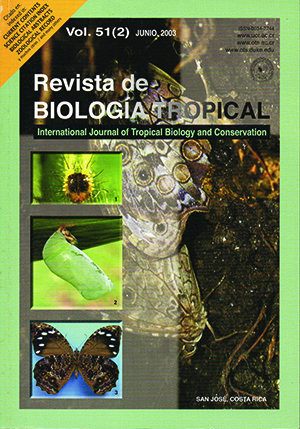Abstract
This paper describes the leaf anatomy of Sabal mauritiiformis (Karst.) Griseb. & H. Wendl., Sabal mexicana Mart. and Sabal yapa Wright ex Becc., three of the four most representative species of the Yucatán Península, in Mexico. These species are locally used: in the roofing of traditional homes, as food (fruits and apical buds), and in the production of hats, brooms and handicrafts. Leaf samples were collected in secondary growth of lower montane rainforest in the state of Quintana Roo and in two home gardens in the state of Yucatán. Herbarium samples were obtained, and samples of blade and petiole were fixed in formaline-acetic acid-alcohol. Cross incisions were made on the blade and petiole, and were dyed with safranin and toluidine blue O. The results show that S. mauritiiformis and S. yapa are morphologically alike: both are tall, slim palm trees; the leaf in S. mauritiiformis is a shorter palm-like structure compared with the other two species. The shape of the main nerve, as seen in cross section, is rectangular in the three species. The hastula in the three species is acuminate and adaxial. The foliar anatomic structure is similar in the three species, although there are some differences. The adaxial an abaxial epidermis of the blade consist of one layer and, superficially, the anticlinal walls are straight; the stomata are intercostal, of the tetracytic type, present on both surfaces in S. mexicana and S. yapa and only on the abaxial surface on S. mauritiiformis. The hypodermis is one layer thick in S. yapa and in S. mexicana and two layers thick in S. mauritiiformis. In the three species the palisade parenchyma consists of several undefined strata as the cells are similar -in shape and size- to the cells in the spongy parenchyma, so there is no marked difference between these strata and the spongy parenchyma seems almost continuous. Both fibrous and vascular bundles are distributed between the hypodermis and the palisade parenchyma; the fiber bundles can be found towards the abaxial surface while the vascular and fiber bundles are located towards the adaxial surface. The fibers, in the three species, are elongated, with the pointed tips, undivided and unseptated. One to three wide vessels of metaxilem can be seen in the vascular bundles, those in S. yapa being the widest in diameter. The vascular bundles are surrounded by thick fiber sheaths which come in pairs. The anatomic structure of the petiole is similar to that of the blade, and is characterized by the many vascular and fiber bundles dispersed in the parenchymatous tissue, and which are very resistant. The histological structure of the blade and petiole reflects strength and flexibility, qualities which make these plants adequate in the construction of roofs for rural housing and other buildings.
##plugins.facebook.comentarios##

This work is licensed under a Creative Commons Attribution 4.0 International License.
Copyright (c) 2003 Revista de Biología Tropical
Downloads
Download data is not yet available.


